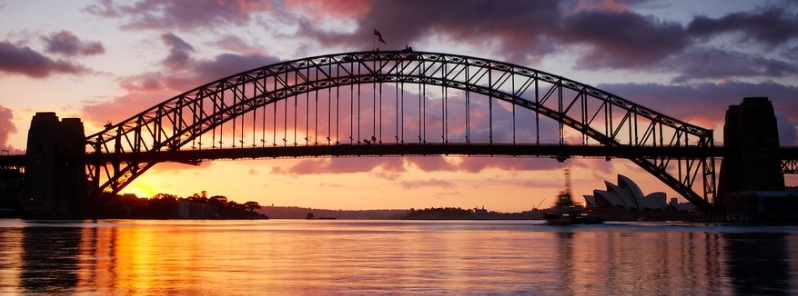Sydney swelters through hottest November night as severe heatwave grapples Australia

Parts of the south and southeast Australia are in the grip of severe to extreme heatwave, with temperatures soaring into the mid-40s °C (104s °F) and total fire bans in place in South Australia, New South Wales, and Victoria. The extreme weather conditions led to Sydney recording its hottest November night, with the mercury not dropping below 25.3 °C (77.5 °F), according to the Bureau of Meteorology (BOM).
In South Australia, residents began to feel very hot weather conditions on Friday, November 27, which continued into Saturday, November 28, with temperatures hitting 46 °C (114. 8 °F) in Port Augusta and Coober Pedy.
A grassfire north of Adelaide grazed through 650 ha (1 606 acres) on Friday, triggering an extreme bushfire risk declaration for the Adelaide Hills. The state’s Country Fire Service advised people at high-risk areas to monitor any updates and put their bushfire plans into action.
"Whilst people in dug-outs will be fine today, we really are concerned about the people that live above ground in housing, in houses above ground and also people that are visiting from other parts of the state, particularly from up north," Dean Miller, the Coober Pedy district council chief executive, told ABC.
"We’ll be looking out for people to make sure they stay hydrated and have access to water and shade."
A hot start this morning for Phil Perkins, SA Manager of Hazard Preparedness and Response. At the press conference launching this year's shark patrols he detailed the hot weather and the relief to most parts of the state by late Saturday. Latest info; https://t.co/8Z3strdgce pic.twitter.com/Omqw1CAUnD
— Bureau of Meteorology, South Australia (@BOM_SA) November 27, 2020
In NWS, temperatures surpassed 40 °C (104 °F) across the west and in coastal areas on Saturday. Much of Sydney sweltered through the mid-40s as powerful north-westerly winds held back the breeze, with the highest temperature of 41.7 °C (107 °F) recorded at the airport.
According to BOM manager Jade Golding, November records for warmest overnight minimums likely fell on Friday night. The overnight temperature did not drop below 25.3 °C (77.5 °F) in central Sydney Saturday into Sunday, November 28 into 29, making it the hottest November night since record-keeping began.
Golding added that the weekend heat would likely raise bushfire concerns, with the Rural Fire Service forecasting severe danger across NSW's southern regions, including the Riverina.
A total fire ban was issued for much of eastern and north-eastern NSW for Sunday, including Greater Sydney, Illawarra, the Hunter, and the north coast.
Sydney, Australia, beaches were packed during the first heatwave of summer on Saturday, prompting concern among officials over social distancing; drones were deployed for crowd control. pic.twitter.com/ONQTlNFrxO
— CBS News (@CBSNews) November 29, 2020
"This is the first time since the devastating season last year we’ve seen widespread elevated fire danger," said RFS deputy commissioner Peter Mckechnie as he urged residents to have a fire plan ready. "Know what to do if a fire threatens you, know where you’ll go."
Temperatures across NSW are expected to rise again on Tuesday, December 1, as heatwave conditions sweep across inland areas.
In Victoria, temperatures in Mildura reached 45 °C (11 °F). The previous record for November was 45.5 °C (113.9 °F) set in 2012.
Fire bans were also declared for the Mallee, Wimmera, and northern county regions. "The Mallee district will reach an extreme fire danger rating for the first time this season due to the forecasted gusty winds and increased grassland curing in the area," said Alen Slijepcevic, acting chief officer of the state's Country Fire Authority.
"Northern country and Wimmera will also experience elevated dangerous fire conditions, with a severe fire danger rating. As a result, we have declared a total fire ban across all three weather districts."
In southeast Queensland, records are set to be smashed as hot temperatures are expected to last into next week. Birdsville can expect 46 °C (114.8 °F) on Wednesday, December 2, while elsewhere in the south, a top of 45 °C (113 °F) is forecast for Cunnamulla.
A sweltering heatwave has delivered scorching temperatures across the country, but for some parts of Queensland, the worst is still yet to come. @R_DAlessandro9 #9News pic.twitter.com/sPAlrvUjyD
— 9News Queensland (@9NewsQueensland) November 29, 2020
Severe Weather Update: Severe to Extreme #heatwave for eastern Australia. Video current at 1 pm AEDT Monday 30 November 2020.
Stay up to date with the latest forecasts and warnings at https://t.co/09iybmRLOA and listen to advice from emergency services. pic.twitter.com/wXdKt2JIPY
— Bureau of Meteorology, Australia (@BOM_au) November 30, 2020
Featured image credit: Adam Smith/Flickr

And what are / were the cultural practices of the Australian Aborigines in such circumstances?
https://electroverse.net/agw-cant-explain-australias-extreme-temperature-contrasts/
you might want to mention the other side